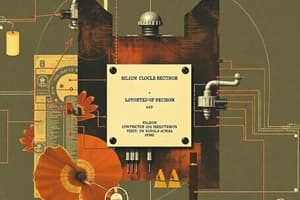Podcast
Questions and Answers
What is a thyristor?
What is a thyristor?
A solid-state semiconductor device with four layers of alternating N and P-type material.
Thyristors are proportional devices like transistors.
Thyristors are proportional devices like transistors.
False (B)
What is the Shockley diode?
What is the Shockley diode?
A four-layer pnpn semiconductor diode with only two external terminals.
Which statements are true about the Shockley diode? (Select all that apply)
Which statements are true about the Shockley diode? (Select all that apply)
What is a Silicon Controlled Rectifier (SCR)?
What is a Silicon Controlled Rectifier (SCR)?
Match the following thyristors with their description:
Match the following thyristors with their description:
Flashcards are hidden until you start studying
Study Notes
Thyristor
- A solid-state semiconductor device with four layers of alternating N and P-type material.
- Acts as a bistable switch, conducting when its gate receives a current trigger, and continues to conduct while forward biased.
- Controls a relatively large amount of power and voltage with a small device, making it widely applicable in electric power control.
- Not a proportional device like a transistor, operating only fully on or fully off, making it unsuitable as an analog amplifier.
- Capable of a Latching Action.
Types of Thyristors
- Unilateral or Unidirectional Devices:
- Shockley Diode
- Silicon Controlled Rectifier (SCR)
- Silicon Controlled Switch (SCS)
- Gate Turn Off Switch (GTO)
- Light Activated Silicon Controlled Rectifier (LASCR)
- Bilateral or Bidirectional Devices:
- Diac
- Triac
Shockley Diode
- A four-layer pnpn semiconductor diode with only two external terminals.
- Named after physicist William Shockley.
- One of the first semiconductor devices invented.
- Small signal Shockley diodes are no longer manufactured, but the unidirectional thyristor breakover diode, also known as the dynistor, is a functionally equivalent power device.
- No trigger inputs, only way to switch it on is to increase the anode-to-cathode voltage VAK to the forward switching voltage, and the only way to open it is by low current drop out.
- Forward switching voltage Vs is equivalent to the SCR forward breakover voltage, and the minimum current at which the device will switch on is the switching current IS.
Breakover Characteristic of Shockley Diode
- Voltage-current characteristic of a Shockley diode shows two operating states: conducting and non-conducting.
- In non-conducting state, it operates on a lower line with negligible current and a voltage less than switching voltage or breakover voltage.
- When the voltage tries to exceed the breakover voltage, the device breaks down and switches along the dotted line to the conducting or on-state.
- In conducting state, the device operates on the upper line, as long as the current through the device is greater than the holding current IH, then the voltage across it is slightly greater than knee voltage VK.
Silicon Controlled Rectifier (SCR)
- A three-terminal device used to control relatively large currents to a load.
- Can be latched by breakover voltage or by exceeding the critical rate of voltage rise between anode and cathode.
- Has a gate terminal that can be used to lower the need breakover voltage to turn on an SCR.
- First introduced in 1956 by Bell Telephone Laboratories.
Ways to Turn Off the SCR
- Force Commutation Technique
- Anode Current Interruption
Silicon Controlled Switch (SCS)
- A four-layer pnpn device with all four semiconductor layers available with the addition of an anode gate.
- Characteristics are essentially the same as those for the SCR.
- Anode gate connection can be used to turn the device either on or off.
Ways to Turn Off the SCS
- Not specified in the text.
Gate Turn-Off Switch (GTO)
- Has the same function as SCR and SCS.
- Can be turned on or off by applying the proper pulse to the cathode gate.
- A consequence of this turn-off capability is an increase in the magnitude of the required gate current for triggering.
Ways to Turn Off GTO
- Not specified in the text.
Light Activated Silicon Controlled Rectifier (LASCR)
- An SCR whose state is controlled by the light falling upon a silicon semiconductor layer of the device.
- A gate lead is provided to permit triggering the device using typical SCR methods.
- Usual implementation is an IC type of Opto-isolator where the light source and LASCR are in one package.
Diode AC (DIAC)
- A two-terminal parallel-inverse combination of semiconductor layers that permits triggering in either direction.
- Characteristics demonstrate that there is a breakover voltage in either direction.
- Breakover voltage is typically around ±25 to 35 volts.
DIAC – Characteristic Curve
- The device blocks the flow of current in both directions until the applied voltage is greater than VBR, at which point breakdown of the device occurs and the diac conducts heavily.
- In an ordinary zener diode, the voltage across it would remain constant as the current increased. However, in the diac, the transistor action causes the voltage to reduce as the current increases.
Triode AC (TRIAC)
- Fundamentally a diac with a gate terminal for controlling the turn-on condition of the bilateral device in either direction.
- Either direction, the gate current can control the action of the device in a manner very similar to that demonstrated for an SCR.
- Characteristics in the first and third quadrants are somewhat different from those of the diac.
Studying That Suits You
Use AI to generate personalized quizzes and flashcards to suit your learning preferences.





